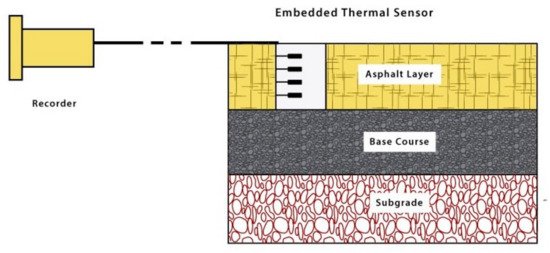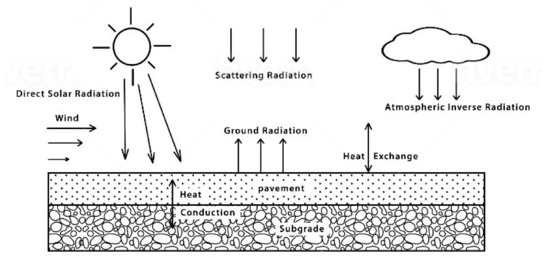The performance of bituminous materials is mainly affected by the prevailing maximum and minimum temperatures, and their mechanical properties can vary significantly with the magnitude of the temperature changes. The given effect can be observed from changes occurring in the bitumen or asphalt mixture stiffness and the materials’ serviceable life. Furthermore, when asphalt pavement layer are used, the temperature changes can be credited to climatic factors such as air temperature, solar radiation and wind.
Note: The following contents are extract from your paper. The entry will be online only after author check and submit it.
1. Introduction
Temperature distribution is the one of the most contributing environmental factors which affects the mechanical properties of flexible asphalt paving mixtures and the asphalt pavement structure’s bearing capacity [
1,
2]. To briefly define, pavement temperature is defined as the changes in pavement surface temperature with the variation in weather parameters over time as influenced by the paving materials and direct solar reflectance, thermal conductivity, thermal emittance, specific heat, and surface convection [
3,
4]. It should be noted that, Bituminous and asphalt mixtures are temperature sensitive materials, and therefore their strengths and modulus vary with the change in temperature. As a result of this, different types of damages could occur in flexible pavements. For example, the decreasing temperature can risk pavements crack, while high temperatures can result in rutting (permanent deformation) [
5]. It is also been observed that the temperature in one section of an asphalt pavement varies due to several reasons. To better understand, pavement responses are affected primarily by ambient temperature, followed by solar radiation (during the hot season); the effect of wind speed and relative humidity, however, is less significant [
6,
7]. Thus, these parameters are considered as the necessary parameters in a pavement temperature prediction model [
8,
9]. Furthermore, extensive research on temperature prediction models has been conducted in several regions with different climates to formulate pavement temperature prediction models that provide the highest accuracy [
2]. Several researchers have also raised their concern about temperature algorithms’ precision and the consequences of using predicted values by emerging technologies of deep learning-based regression models for calculating asphalt pavement temperature [
10,
11].
2. Measurements of Pavement Temperature
The pavement surface temperature measurement which is based on creating a pavement temperature prediction model enables us to gather the relevant pavement temperature data. shows the design of a mobile and dependable system which is used for collecting continuous and consistent measurements of temperature fluctuations occurring in an asphalt pavement section [
12].
Figure 1. Representation of a pavement temperature measurement system.
The provided system has been used extensively in many researches on-site, and the temperature measurement system of those researches should meet the following requirements [
12]:
-
The thickness of the flexible pavement base course and wearing surface required should be less than 35 cm.
-
The measurement site must have proper ventilation and be able to receive sufficient sunlight without being shaded by trees or buildings.
-
The measurement point must be easily reachable by the power supply and protection facilities for the temperature recording and measuring system.
-
A weather station must be present not more than eight km away from the measurement site to provide real-time climate data.
3. Primary Factors Influencing Pavement Temperature
Environmental factor variations may influence pavement temperature variations and hence ultimately affecting the stiffness and degradation of pavement materials, thereby influencing their performance in-service. However, these factors are always considered in pavement design and field installation [
13,
14]. For example, in order to meet the functional and structural requirements, the selection of bituminous binder grade is determined to address the local temperature condition [
13,
15]. Even though environmental factors are given serious consideration in pavements, distresses resulting from variations in these factors are unavoidable and are often significant [
16,
17,
18]. The previous researcher investigated the effect of the environment on the pavement performance and reported influences on pavement environmental conditions (e.g., temperature and moisture profiles) in assessing material responses and predicting long-term performance [
19].
Furthermore, the increase in the temperature ranges due to weather and climate changes were reported to increase thermal stresses in asphalt layers and that more thermal cracking could be expected as a result [
20]. In addition to these, higher temperature can lead to faster (accelerated) ageing of asphalt layers, and pavements could hence become more prone to cracking due to increased brittleness [
21,
22,
23]. Additionally, low temperatures may lead to the hardening of asphalt concrete and subsequently results in thermal cracks being generated on the road surface. Also, the low temperature was prone to accelerate cracking processes while high temperature distorts processes, leading to plastic deformation such as rutting [
24,
25,
26,
27].
illustrates the heat conduction within a pavement structure and subgrade and the convection process due to heat transfer between the pavement surface and the surrounding environment, where the latter takes place through a transmission medium, such as air or when water reaches the surface [
28,
29]. However, in most investigations on the climatic variables, temperature variations were considered the most responsible factor for the varying pavement performance [
30,
31]. Therefore, it is prudent to understand the mechanisms for seasonal variations and their impact on temperature changes [
32,
33,
34]. Furthermore, it is widely known that the pavement layers’ response to traffic loads is highly influenced by environmental factors such as temperature and moisture. Therefore, any significant temperature change could severely impact asphalt pavement performance and the rehabilitation requirements [
35,
36,
37,
38].
Figure 2. Factors influencing asphalt pavement temperature.
3.1. Influence Mechanisms
Most pavements are exposed to their surrounding environments, significantly influencing their internal pavement temperatures [
39,
40]. Diffused and direct solar radiation, which is considered the essential factors, generally has short wavelengths [
41]. As shortwave radiation reaches the asphalt pavement surface, the pavement layers start absorbing a relatively high amount of energy, transmitted as heat flux in the pavement structure whilst the surface reflects the remaining heat towards the sky [
1]. It should be considered that asphalt pavements are not only affected by climate variations but also contribute to them [
41]. The reasons for this are two-fold. Firstly, a large amount of Greenhouse Gas (GHG) is emitted in various phases of a pavement’s life cycles. Secondly, asphalt roads cover significant proportions of urban areas. Moreover, road pavements store and release more heat than soils, aggravating urban heat island (UHI) effects. Consequently any action to reduce such emissions could potentially contribute to mitigating GHG emission on heavily trafficked roads [
42].
The amount of reflected and absorbed energy is influenced by cloud cover, precipitation, and pavement surface temperature [
43]. The pavement surface concurrently radiates the long-wave radiation as a black body [
44]. The net value of that long-wave radiation energy (input long-wave radiation minus pavement emitted long-wave radiation) is known as the effective long-wave radiation [
45]. Hence, it may be affected by cloud cover, pavement surface temperature, air temperature, and relative humidity. Direct solar radiation and diffuse scattered solar radiation are also shortwave radiations and can be regarded as incoming shortwave radiation. The combined incoming solar radiation and effective long-wave radiation is called solar radiation [
17]. Therefore, it is safe to say that heat can be transferred primarily by air, dynamic terrestrial radiation, and solar radiation [
12,
40,
46].
3.2. Moisture Effect
Moisture affects the chemical, biological, and mechanical processes of decay [
6]. The moisture formed due to the reaction between asphalt pavement surface and adsorbed water particles is deposited within the asphalt pavement surface [
7]. However, it may also be generated by the moisture entrapped within the asphalt layer, leading to the build-up of pore pressure arising on account of repeated traffic loads and freeze-thaw cycles. Furthermore, the moisture layer, when combined with temperature, serves as a conductor in electrochemical reactions and a medium for the chemical reactions of surface contaminants. Two critical variables in the damage caused by humidity are the relative humidity of air and dew point [
47].
3.3. Solar Radiation Effect
Solar radiation causes a change in the temperature of bituminous materials, which can in turn can cause a change in the volume of pavement structures in the pores due to the expansion of water when exposed to the higher amount of heat from solar radiation [
48]. Thus, solar radiation causes indirect and diffuses heat gain on the pavement via solar absorption [
49]. Moreover, Solar radiation is also plays a vital role in photochemical reactions since it is the energy source for the excitation and breaking of bonds within the reacting molecules [
7,
14,
50]. Therefore, a sufficiently intense solar radiation with appropriate wavelengths could trigger photochemical reactions which can cause damages to pavement materials [
14].
3.4. Wind Effect
The wind speed also affects pavement temperature. The difference in pavement surface temperature and air temperature can result into a convection loss from the pavement to the air. The amount of lost energy is determined by wind velocity and the difference between air temperature and pavement surface temperature. Furthermore, the heat exchange that occurs on the pavement surface causes a variation in pavement surface temperature; this results in a difference in the pavement surface temperature and the pavement structure’s temperature as the energy is dispersed to the pavement structure. Another factor influencing pavement temperature is wind speed. However, in reality, wind speed and wind direction are consistently changing. Wind speed for a given stretch of road may differ due to variations in layout and profile of, and any obstacle along, each road section. Therefore, the inclusion of the influence of wind speed in temperature prediction models could be complex.
Therefore, as the wind speed affects pavement temperature [
12,
51,
52]. Asphalt pavement materials are affected in different ways by rising wind velocity [
13]. Hence accordingly, the wind-water pushes the air’s portable particles to the pavement surface, where they cause local attrition and material deterioration [
53,
54]. In addition to this, wind velocity also influences the particle kinetic energy and the degree of inertial impaction of droplets on the materials surface [
55]. The change in structure volume is influenced by both drying and wetting processes [
56,
57].
This entry is adapted from the peer-reviewed paper 10.3390/app11093794


